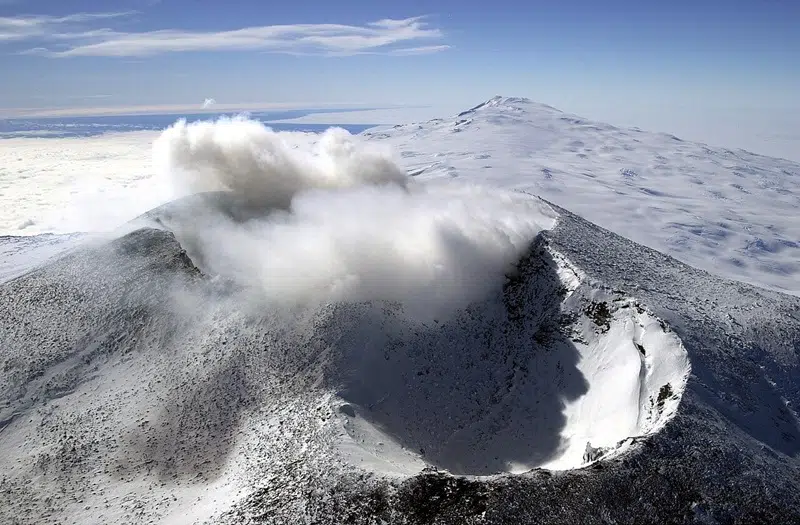
An active volcano in Antarctica is shooting $6,000 in gold dust into the air every single day, NASA’s Earth Observatory revealed last week.
The volcano on Mount Erebus spits pockets of gas containing 80 grams of crystallized gold daily, it said.
Mount Erebus, is arguably Antarctica’s most famous volcano. It holds the titles of the tallest active volcano on the continent, with its summit reaching 12,448 feet (3,794 meters), and the southernmost active volcano on Earth.
Named after the personification of darkness in Greek mythology, Mount Erebus was erupting when Captain Sir James Clark Ross first discovered it in 1841. It sits alongside two other volcanoes on Ross Island, which bears the name of the aforementioned British explorer.
The new finding remains consistent with the 1991 spotting of gold emission from the volcano. Both then and now, researchers have detected gold particles in the volcanic gases emitted by the volcano, as well as in surrounding snow.
Gold deposits likely originated from volcanic rock
Philip Kyle, from the New Mexico Institute of Mining and Technology in Socorro, clarified that gold deposits can originate in volcanic rock.
When lava from the mountain emits hot gas, this carries some of the gold particles into the air.
Mount Erebus apparently spits gold flecks measured between ‘0.1 and 20 micrometers’ in the volcanic gases and ’60 micrometers’ in surrounding snow.
This volcano is among Antarctica‘s 138 active volcanoes. Located on Ross Island in Antarctica, the volcano holds importance due to a tragic event in 1979 when Air New Zealand Flight 901 crashed into its side, resulting in the loss of all passengers and crew.
Gold detected 621 miles from Erebus’ volcano
The National Aeronautics and Space Administration (NASA) Earth Observatory reported that the precious metal dust has been detected as far as 621 miles from Erebus’ southernmost lava-spewer. This is 12,448 feet high (3,794.02 meters), as part of other spewing phenomena.
NASA stated, “It regularly emits plumes of gas and steam and occasionally spits out rock (bombs).”
Conor Bacon of Lamont-Doherty Earth Observatory at Columbia University, New York, says that this volcano has been continuously erupting since 1972.
Bacon said that Erebus is also understood to comprise a “lava lake” at one of its summit craters.
Minimal impact on the gold market
While the concept of a volcano that spews gold daily is fascinating, its impact on global demand for gold would likely be minimal unless the conditions for collection and processing undergo significant changes, making it much more economically practical, per Mugglehead.com.
The impact of a volcano that produces about 80 grams of gold per day is minimal when considered against the global annual gold production of over 3,000 tones, making the volcanic contribution relatively insignificant.
Even if collectors could efficiently gather this gold and integrate it into the global market, there might be a slight increase in the overall gold supply.
However, the challenging and remote conditions of Antarctica pose significant logistical hurdles that could prevent this.
Additionally, the costs of extracting and transporting the gold from such an inhospitable location are likely to outweigh the value of the gold itself, rendering the operation economically unfeasible with current technology and market prices, Mugglehead.com says.
Related: The River Of Gold in British Columbia
See all the latest news from Greece and the world at Greekreporter.com. Contact our newsroom to report an update or send your story, photos and videos. Follow GR on Google News and subscribe here to our daily email!



